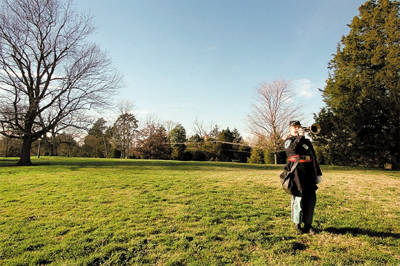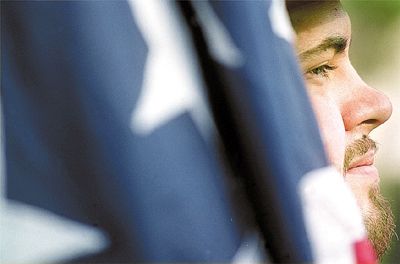
REZ MARVASHTI / The Free Lance–Star

REZ MARVASHTI / The Free Lance–Star |
Gregg S. Clemmer doesn’t want to glorify war.
Instead, the Maryland-based writer wants to use the Civil War as an example of how heroic acts can be incorporated into daily life.
“We’re on the threshold of a new millennium,” said Clemmer, who wrote “Valor in Gray: The Recipients of the Confederate Medal of Honor.”
“Who are your heroes? You don’t have to be a war hero to be a hero in life.”
Clemmer, a Virginia native and graduate of Virginia Tech, was yesterday’s keynote speaker at a ceremony marking the 137th anniversary of the Battle of Fredericksburg.
With blue sky overhead, and the afternoon temperature comfortably in the mid-50s, nearly 80 people turned out for the memorial event, which included period costumes, field music and a wreath-laying ceremony.
Clemmer spoke passionately about the three-day battle in 1862, when the two sides clashed in Fredericksburg, leaving 18,053 men dead or wounded.
“Dead men were lying on sidewalks and in [people’s] gardens,” Clemmer said. “The night out here was one of horror.”
Yesterday’s ceremony took place at the statue of Confederate Sgt. Richard
Kirkland near the Fredericksburg Battlefield Visitor Center off Sunken
Road and Lafayette Boulevard.
 Historian Josh Bucchioni with the 47th Virginia Infantry's I company, formed in Stafford County, stands behind the Confederate battle flag during a speech. |
A young South Carolinian, Kirkland risked his life during the battle to ease the suffering of Union soldiers.
Tortured by the constant shrieks for “Mother, God and water,” Kirkland crossed enemy lines to bring water to the fallen troops.
For an hour and a half, Kirkland cradled the heads of numerous soldiers, tipping his canteen into their mouths. He also took time to button their coats, protecting them from the cold.
“He risked death for the enemy,” Clemmer said. “He was on a mission of mercy.”
The sculpture of Kirkland, also known as the Angel of Marye’s Heights, was just one of the area sites at which people yesterday commemorated the battle.
Kenmore Plantation, home of Fielding and Betty Lewis, George Washington’s only sister, offered visitors a chance to talk with re-enactors camped on the mansion’s grounds, as well as to tour the home.
After Clemmer’s remarks along Sunken Road, a wreath was placed by host organizations, which included the United Daughters of the Confederacy, the Order of the Southern Gray, the 18th Massachusetts Infantry and the 47th Virginia Infantry.
The event concluded with the strains of “Taps” emanating from a lone bugler on the Brompton hill along Marye’s Heights.
Clemmer drew parallels between battlefield heroism and acts of courage found every day.
“You can shed some blood for your country by going down to the Red Cross,” he said. “Or digging deep within yourself and signing an organ donor card.
“This should inspire us to follow their lead in our daily lives.”